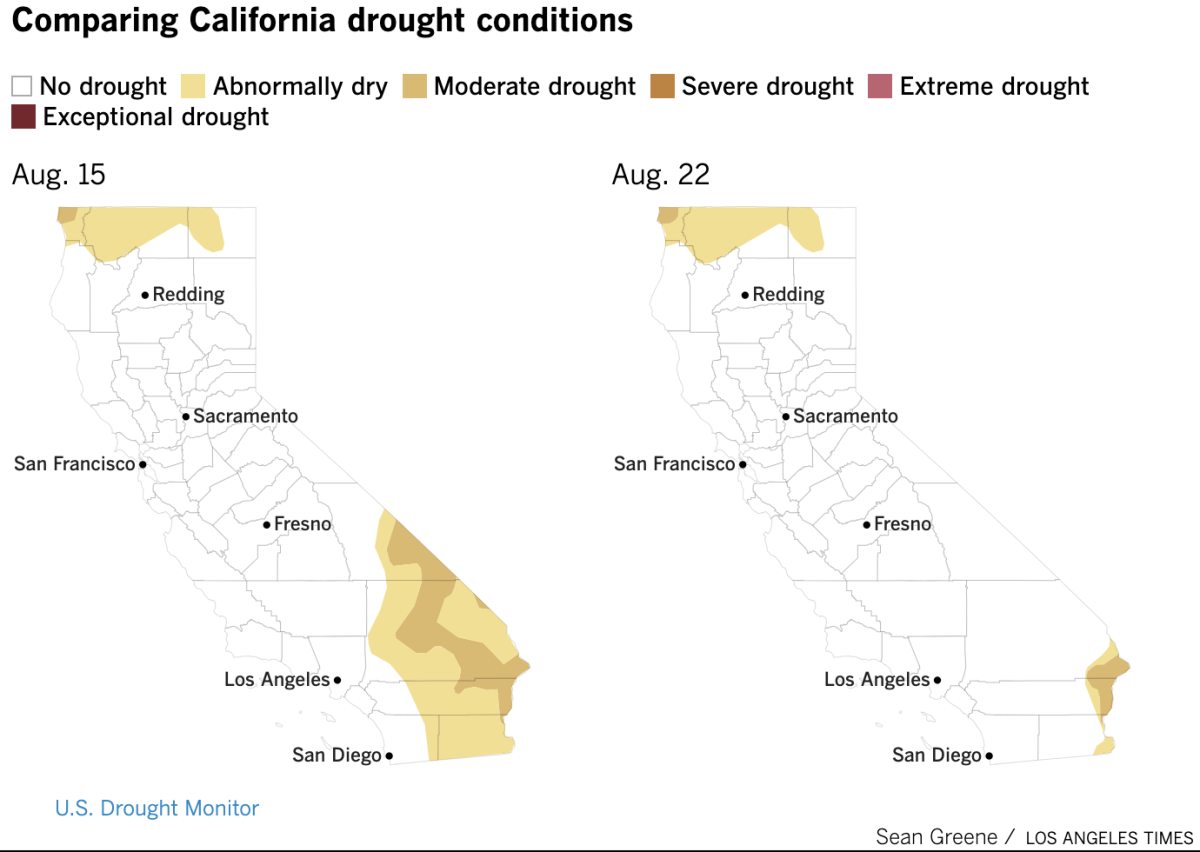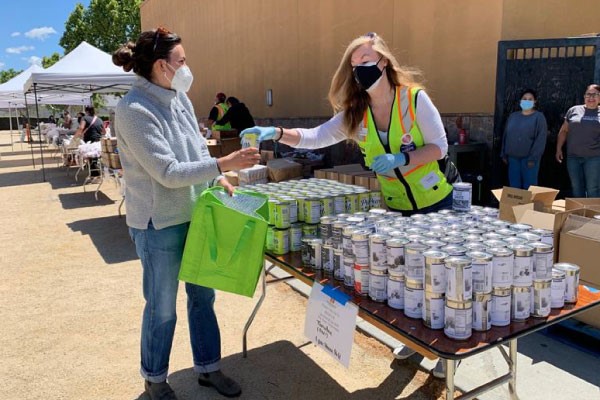Good morning, and welcome to the Essential California newsletter. It’s Wednesday, Aug. 30.
The epic summer rainfall that Hurricane-turned-Tropical-Storm Hilary dumped on California as it spun across the state last week further reduced drought conditions in regions long dried out.
Nearly all of California’s Mojave Desert has been deemed drought-free after receiving 2 to 6 inches of rain region-wide.
But just as we saw with the parade of atmospheric rivers last winter, our systems were mostly unprepared to hold on to much of that water. That remains an “urgent challenge” to the state as it works to capture more rainwater to replenish depleted groundwater sources, my colleague Grace Toohey reported.
“State and local officials have been actively working to improve methods to capture stormwater, but it’s simply not been fast enough to keep up with growing water demands in a more extreme climate — while balancing flood control,” she wrote this week.

Art Castro, a watershed manager for L.A.’s Department of Water and Power, told Grace they captured roughly 3.2 billion gallons from Hilary’s downpour, about a year’s worth of water for 40,000 households.
But that accounts for only about 7% of the water the city has captured since October, he said, citing “limitations of our infrastructure.”
According to the Pacific Institute, California’s urban areas let between 770,000 and 3.9 million acre-feet of water spill away annually (depending on how dry or wet the year is).
“We’re not even coming close to capturing all the runoff,” Mark Gold, the director of water scarcity solutions for the Natural Resources Defense Council, told Grace. “We can definitely do a lot more than what we’re doing.”
Although the vast majority of the state is now out of drought conditions, I’m reminded of a conversation I had with hydroclimatologist Peter Gleick back in April when I was trying to understand the impact our major rainstorms had on the state’s historic drought.
Gleick, co-founder and senior fellow of the Pacific Institute, told me even though the U.S. Drought Monitor map showed fewer concerning colors in California, the next drought is a matter of when, not if. He hoped the state’s decision-makers would take advantage of a wetter year “to fix other parts of our water system” rather than “forget that we have a water problem because we had a good year.”
“It’s precisely in the wet years, when we have a little breathing room, that we ought to be doing more to prepare for the dry years that we know are increasingly frequent,” he said.
And now, here’s what’s happening across California from Helen Li and Laura Blasey:
Note: Some of the sites we link to may limit the number of stories you can access without subscribing.
ADVERTISEMENT BY BRISTOL MYERS SQUIBB

To support a robust research and development and manufacturing presence on the West Coast, Bristol Myers Squibb is investing in local communities and supporting local grassroots organizations that promote and expand STEM education, help improve health services for underserved populations and deliver basic human services to those most in need. Learn more about Bristol Myers Squibb’s work building strong, inclusive and equitable communities across California here.
End of advertisement
|
|
L.A. STORIES
After migrating from Tijuana and seeking asylum in the U.S. when he was 13, Cain Carias learned the art of puppetry from Bob Baker. He has now performed at community centers, parks, concerts, schools, quinceańeras and events throughout Los Angeles for 20 years with his puppets El Triste and La Smiley. Read about the lessons that he learned along the way from De Los at the Los Angeles Times.
The co-owner of a Hollywood costume firm filed a lawsuit Tuesday against reality TV star Erika Girardi, two of her staff members, current and former U.S. Secret Service agents and American Express, alleging corruption among federal law enforcement to benefit Girardi and her once-influential husband, former Los Angeles attorney Tom Girardi. In the 70-page suit, Christopher Psaila accuses the couple of having “weaponized the Secret Service to maliciously prosecute” him to secure a $787,000 refund. Los Angeles Times
HOUSING AND HOMELESSNESS
In the Mission District in San Francisco, a 36-bed transitional housing center opened in January. The program has now attracted the attention of a Salesforce tech billionaire, who donated $ 1 million to help fund it. The Way Out aims to transition residents who were formerly in the Salvation Army’s Harbor Light substance-use rehabilitation centers to fully independent living within two to three years. San Francisco Chronicle
The first CARE (Community Assistance, Recovery, and Empowerment) Courts will soon open across the state in seven counties and state lawmakers hope they will be the answer to California’s dual, overlapping homelessness and mental health crises. The program walks the line between voluntary and forced mental health treatments for those with the gravest needs.
No comments:
Post a Comment